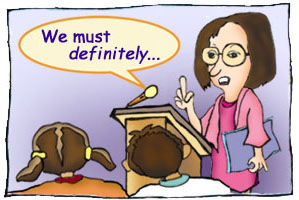Grammar: Groups & phrases: Adverb group
| Expressing 'probability' |
Indicating the degree of certainty
When we think of the function of adverbs, we generally say that they give us more information about actions ('how?', 'when?', 'where?', 'why?'). In other words, they help us describe 'what is going on'. However, adverbs can also function in an interpersonal way, influencing our interactions with others.
One way in which we encourage (or discourage) interaction is by indicating how definite we are about something (referred to grammatically as modality).
 |
If we want to encourage interaction and discussion, we can use modals such as perhaps, possibly or maybe (Maybe we could ...). This is called low modality. When we use low modality, we are indicating that we are willing to negotiate, ie we haven't yet made up our minds and we invite others to put another point of view. |
If we want to sound very definite, however, we can use modals such as certainly, definitely, absolutely. We call this high modality. High modality is often used by people with some authority such as parents, teachers, and employers, or by people with a definite point of view. By using such strong words, we usually discourage people from interacting. It's like a signal saying "Let's just get on with it with no discussion!" |
 |
One way of expressing modality is to use adverb groups:
I think it would quite probably be useful to talk to her first.
We nearly always agree.
| high modality | mid modality | low modality | |
| 'how likely?' | most certainly very definitely |
quite probably | just perhaps quite possibly |
| 'how often?' 'how typical?' |
absolutely always most generally |
quite often | only sometimes just occasionally |
| To find out more about the form and function of adverbs groups describing probability, click here: |  |
For more information on using adverbs and adverb groups to express modality, see ![]() Grammar: Word classes: Adverbs: Expressing 'probability'
Grammar: Word classes: Adverbs: Expressing 'probability'
|
||
To give us feedback about this section, click here or on the Comment button at the top of the screen.
If you have any questions about this section, visit the Language Corner.
If you have any questions or suggestions about how to teach this section, send a message to the Teaching Corner.